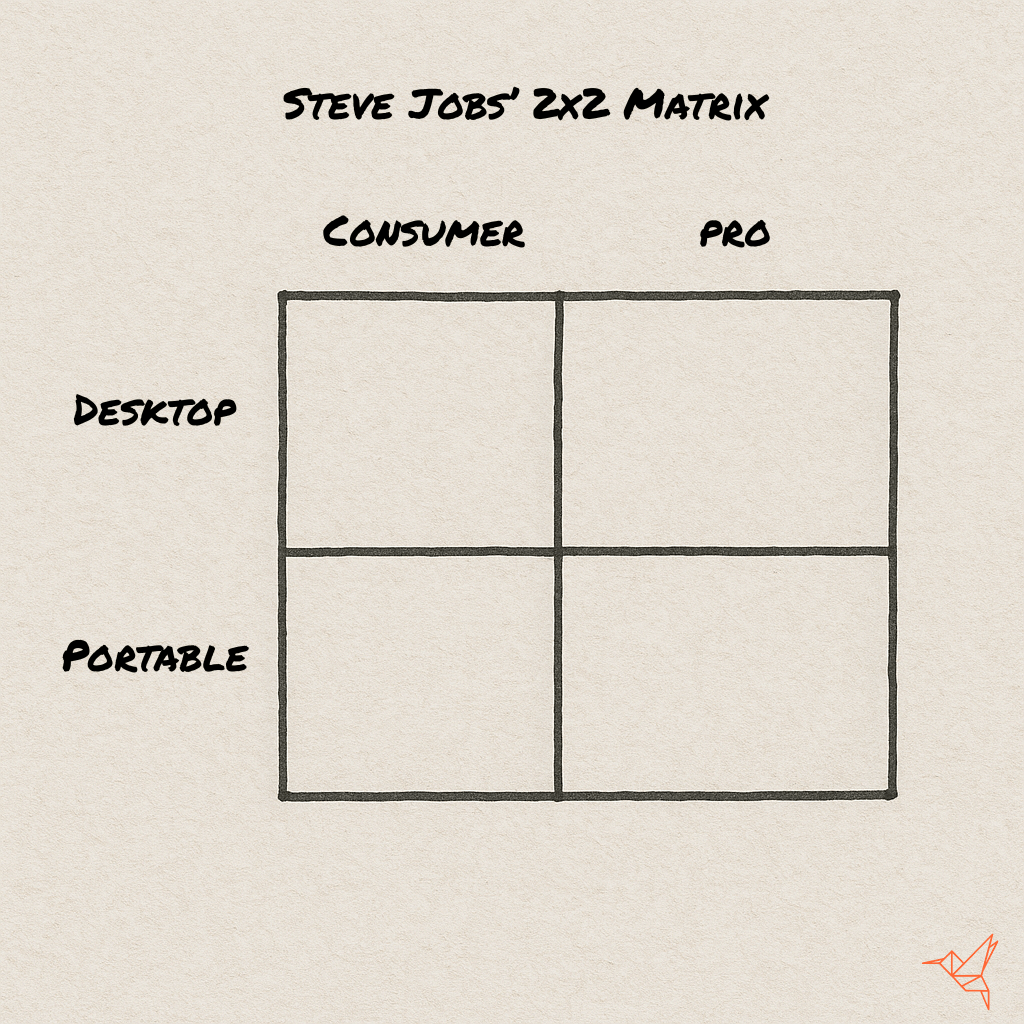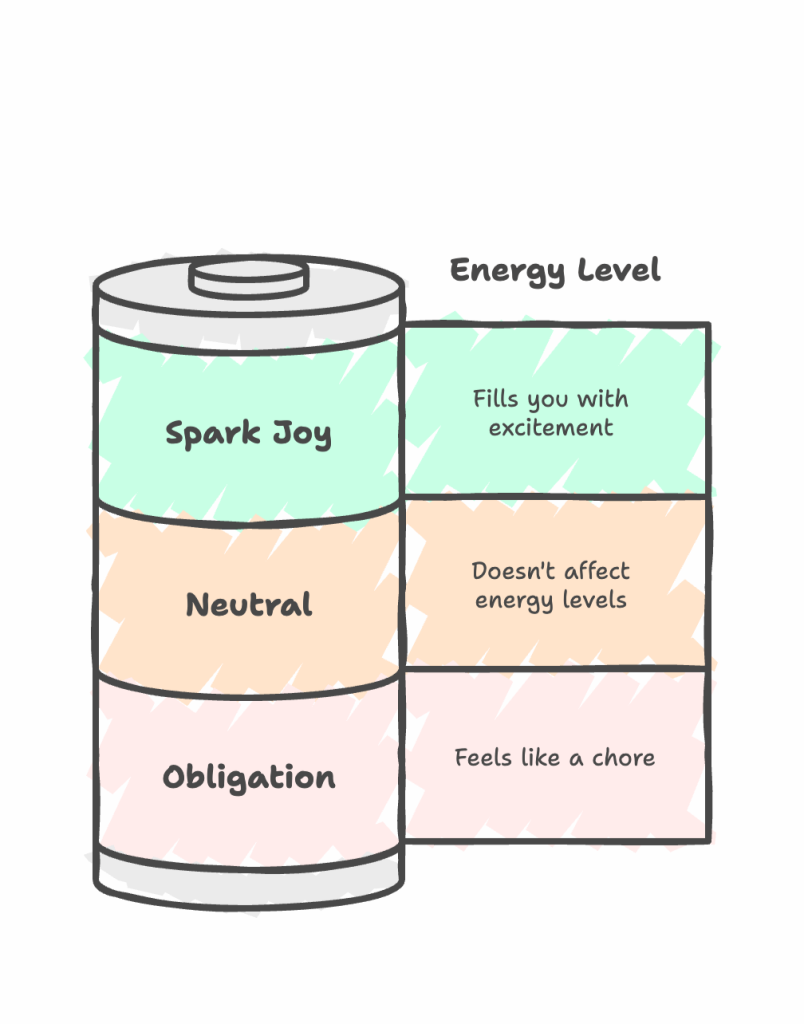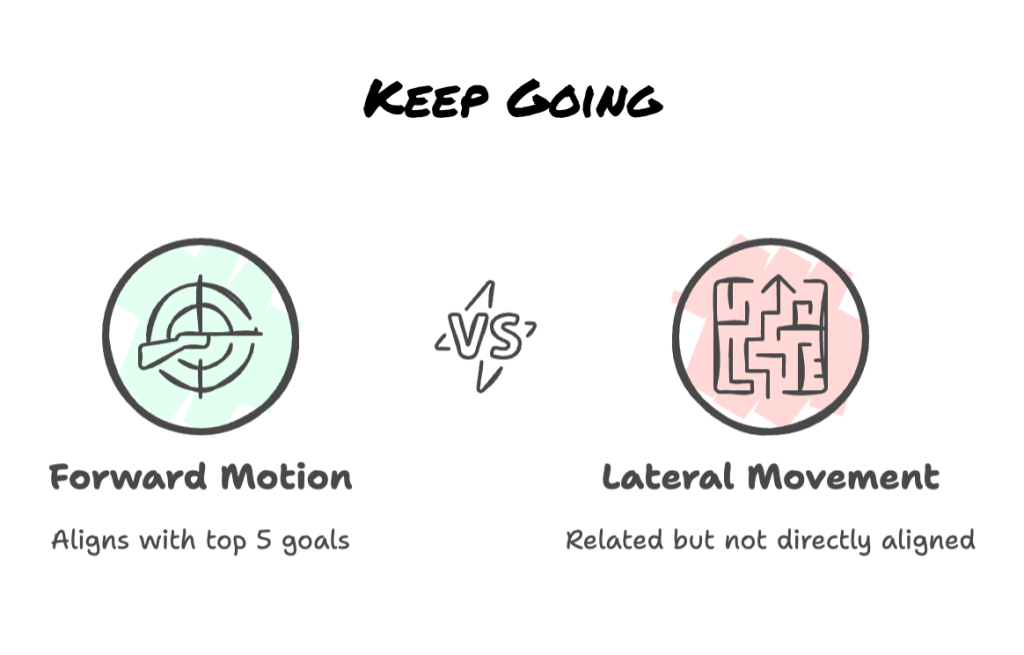Remember when Netflix mailed you DVDs? Three movies max. (If you’re too young to remember that, look away now — this could be scary.)
Back then, you had to be ruthless about what you actually wanted to watch. Your choices mattered because those slots were limited.
Now? We’re blessed — or cursed — with infinite choices. And so is your calendar. You’re drowning in an endless “add to list” you’ll never get to.
Marie Kondo taught millions of people to declutter their homes with one question: “Does this spark joy?”
Hold up that old sweater. Feel something? Keep it.
Don’t feel anything? Let it go. (Oh, and don’t just crumple up your socks.)
That worked for closets. But what about your decisions?
You’re not drowning in movies anymore. You’re drowning in decisions.
Meeting invites. Side project pitches. “Quick call?” requests.
LinkedIn messages with “exciting opportunities.” Slack notifications that could be important. Emails that might lead somewhere.
(Side rant: Let’s not even talk about the daily “Got 20 minutes?” emails. Or is that just me?)
It’s nice. Lots of shiny options.
But it’s a trap.
By the time you’re done reading, you’ll have a simple 3-question filter that helps you say no to good opportunities so you can say yes to the right ones. You’ll know exactly how to cut through the noise and make decisions with clarity.
Because here’s what nobody tells you: Most people never declutter their decisions until it’s too late. They’re busy but not fulfilled. Productive but not progressing.
Your opportunities don’t take up physical space. They take up something more valuable: your clarity.
And unlike Kondo’s closet, you can’t see the pile until you’re buried under it.
Why ‘Pretty Good’ Opportunities Are Killing Your Momentum
When Steve Jobs returned to Apple in September 1997, the company had 90 days of cash left.
Forty different products. Printers. Servers. The Newton PDA. Multiple computer lines. All fighting for attention. All “good” products.
The executive team gathered for an emergency retreat. They tried to figure out which products to save using normal criteria: profitability, market share, customer feedback.
It wasn’t working.
Jobs stood up and drew a simple 2×2 matrix on the whiteboard:

“We’re going to make four products,” he said. “One for each box. That’s it.”
The room went silent.
Now you can imagine someone saying: “But Steve, these are good products. They’re profitable. Customers want them.”
Jobs didn’t blink.
“People think focus means saying yes to the thing you’ve got to focus on. But that’s not what it means at all. It means saying no to the hundred other good ideas that there are. You have to pick carefully. I’m actually as proud of the things we haven’t done as the things I have done. Innovation is saying no to 1,000 things.”
He killed 70% of Apple’s product line.
People thought he was insane. Industry analysts predicted Apple would be dead within a year.
Instead, Apple returned to profitability within 12 months. The iMac became the best-selling computer in America. Within a decade, Apple launched the iPod, then iPhone, then iPad.
Today, Apple is worth over $3 trillion.
But here’s the lesson everyone misses:
Jobs didn’t find better products to focus on. He found a better way to filter decisions.
Those 40 products? Most of them were objectively good. Innovative. Well-designed. Profitable.
They just weren’t essential.
And “pretty good” is the enemy of extraordinary.
(There’s also a story of Jobs giving Phil Knight the exact same advice at Nike.)
Warren Buffett’s ‘Avoid-At-All-Cost’ List (And Why You Need One)
Warren Buffett’s personal pilot, Mike Flint, asked for career advice.
Buffett handed him a notepad.
“Write down your top 25 career goals.”
Flint wrote fast. He’d been thinking about this for years. Promotions he wanted. Skills to develop. Projects to lead. Networks to build.
“Now,” Buffett said, “circle your top 5.”
Flint studied the list. Circled five. The essentials. The big ones.
“Great,” Flint said, looking at the remaining 20. “So I’ll focus on my top 5, and work on these others when I have time.”
Buffett stopped him cold.
“No. Everything you didn’t circle just became your Avoid-At-All-Cost list. No matter what, these things get no attention from you until you’ve succeeded with your top 5.”
Not a “someday” list. Not a “when I have time” list.
An actively avoid list.
Why?
Because goals 6 through 20 are dangerous. They’re good enough to distract you, but not good enough to matter. They FEEL like progress because they’re related to your field. But they’re lateral movement disguised as forward motion.
As Buffett puts it: “The difference between successful people and really successful people is that really successful people say no to almost everything.”
Buffett made his fortune — over $100 billion — by saying no to almost everything. He passed on the entire tech boom of the 1990s. He skipped Google’s IPO. He declined thousands of “good” opportunities.
Not because he didn’t understand them. Because they didn’t pass his filter.
The Broken Questions Most People Use to Make Decisions
Both Jobs and Buffett succeeded by eliminating options, not evaluating them better.
But most people filter decisions using broken criteria:
- “Can I make time for this?” (You can make time for anything)
- “Is this a good opportunity?” (Most things are good on paper)
- “Might this be useful someday?” (The killer question that keeps junk alive)
You’re not saying yes to bad things. You’re saying yes to too many pretty good things.
And that’s what’s killing your momentum.
Tim Ferriss nails it: “If you want confusion and heartache, ask vague questions. If you want uncommon clarity and results, ask uncommonly clear questions.”
The problem isn’t your opportunities. It’s your questions.
So let me give you better ones.
The 3-Question Clarity Filter (Say No to Everything Else)
Marie Kondo asked: “Does this spark joy?”
I’m asking you to go three steps further.
When an opportunity comes up — a meeting invite, a project pitch, a side hustle idea, a “quick call” — run it through these three questions:
- Does this align?
- Does this energize me?
- Does this move me forward?
If it’s not a YES to all three, it’s a NO. (Or, I always love how Derek Sivers puts it. It’s either Fck Yes or it’s a No.)*
Let ‘s take a look at why each question matters.
Question 1. Does This Align With Who I’m Becoming?
Alignment isn’t about logic. It’s about identity.
Most people say yes to opportunities based on external factors: good money, good for the resume, good company. But if it doesn’t align with your values or the person you’re becoming, it’ll drain you.
Chris Guillebeau puts it simply: “Convergence is the state of being where everything in our lives is in alignment.”
When everything aligns —y our work, your values, your direction — you stop fighting yourself.
The test:
- If I get exactly what I want from this opportunity, will it move me closer to the person I want to become?
- Does this fit the life I’m building, or the life I’m leaving behind?
Example:
You get offered a high-paying consulting gig. Sounds great. But you’re trying to build leverage through content and products, not trade time for money.
Doesn’t align. Pass.
Steve Jobs’ 2×2 matrix worked because it aligned with Apple’s identity: great products for consumers and professionals. Everything else—no matter how profitable—didn’t align.
Do this in 5 minutes: Write down your top 3 values. Now look at your calendar for next week. How many commitments align with those values? Circle them. Everything else is negotiable.

Question 2: Will This Give Me Energy (or Drain It)?)
Not “do I have energy for this?” but “will this give me energy?”
Energy is your most valuable resource. Time is finite. Energy is renewable — but only if you protect it.
Paul Smith notes:
“There’s something about leadership that lends itself to the letter E. Jack Welch at GE espoused the four E’s of leadership (energy, energize, edge, execute).”
The best leaders don’t just have energy. They create it. For themselves and others.
Brendon Burchard asks a powerful follow-up: “What is the primary feeling I want to bring to this situation, and what is the primary feeling I want to get from this situation?”
If the answer is “obligation” or “should,” your body is telling you something.
The test:
- When I think about saying yes to this, do I feel excited or exhausted?
- Will this drain my energy for things that matter, or compound it?
Example:
You’re invited to speak at a conference. Prestigious. Good for your brand. But you hate public speaking, and it’ll kill your energy for a week.
Unless it’s absolutely essential to your goals, pass.
Marie Kondo’s “spark joy” is an energy test, not a logic test. She realized people can’t think their way to clarity. They have to feel it.
Do this in 5 minutes: List your current commitments. Mark each with + (energizes me), 0 (neutral), or – (drains me). Anything marked “-” that isn’t essential needs to go.

Question 3: Does This Move Me Toward My Top 5 Goals?
Not “is this good?” but “does this move me toward my top 5 goals?”
Motion isn’t progress. You can be busy all day and move nowhere.
This question forces you to ask: forward toward what?
Bill Campbell (legendary executive coach) taught this principle:
“Failure to make a decision can be as damaging as a wrong decision. Do something, even if it’s wrong.”
This isn’t about perfect decisions. It’s about directional ones.
Ryan Holiday reframes obstacles brilliantly:
“It’s not just: How can I think this is not so bad? No, it is how to will yourself to see that this must be good — an opportunity to gain a new foothold, move forward, or go in a better direction.”
Even obstacles can move you forward if you filter them correctly.
The test:
- If this works perfectly, will I be closer to my top 5 goals?
- Is this the BEST use of my limited time, or just a GOOD use?
Example:
Someone invites you to join a working group on a topic adjacent to your work. Interesting, but not directly related to your goals. It might be useful someday.
Pass.
Remember Buffett’s warning: Goals 6-20 feel like forward motion because they’re related to your field. But they’re lateral movement disguised as progress.
Do this in 5 minutes: Write down your top 5 goals (Buffett’s exercise). Now list everything on your plate this week. How many actually move you toward the top 5? The rest is distraction.

How a Layoff Taught Me to Filter Ruthlessly
A few years ago, I got laid off during a corporate downsizing.
On paper, I was fine. Good severance. Strong resume. Plenty of options.
In reality? I was stuck.
Projects had been stalling for months. Creativity was limited. Growth opportunities were scarce. I’d been busy but not fulfilled. Productive but not progressing.
The layoff forced me to ask a question I’d been avoiding:
What do I actually want?
Not what looked good on LinkedIn. Not what paid well. Not what I “should” want.
What did I want?
I got clear: authenticity, growth, empathy, transparency.
Those four values became my filter.
Every opportunity that came next, I ran through three questions:
- Does this align with who I’m becoming?
- Does this energize me or drain me?
- Does this move me toward the work I want to be doing?
I said no to opportunities that looked good on paper but didn’t fully pass the filter.
I said yes to things that aligned perfectly for a way forward.
The filter works. But only if you use it ruthlessly.
How to Start Filtering Your Opportunities This Week
You don’t find clarity by evaluating everything. You find it by filtering like your life depended on it (because it kinda does.)
Marie Kondo taught you to ask: “Does this spark joy?”
I’m asking you to go three steps further:
- Does this align with who I’m becoming?
- Does this energize me?
- Does this move me forward?
Three questions. Every opportunity. No exceptions.
Imagine your calendar filled only with work that lights you up. Imagine saying ‘no’ without guilt because you know exactly where you’re going. That’s what’s possible when you set those filters.
The truth is, you’ll say no to 90% of things. Maybe more.
But that’s how you build something extraordinary.
Clarity is the child of careful thought and mindful experimentation. It comes from asking yourself questions continually and further refining your perspective on life.” — Brendon Burchard
Steve Jobs killed 70% of Apple’s products and saved the company.
Warren Buffett avoided thousands of opportunities and became one of the richest people alive.
You don’t need more opportunities.
You need better questions.
This week, do this:
Take Buffett’s exercise. Write down your top 25 goals. Circle the top 5. Everything else goes on your “Avoid-At-All-Cost” list.
Then look at everything on your calendar for next week. Run each commitment through the three questions.
If it’s not a YES to all three, it’s a NO.
Don’t wait for permission. Don’t wait until you feel ready.
Start filtering today.
FAQ
Use a 3-question filter: (1) Does this align with who I’m becoming? (2) Does this energize me? (3) Does this move me toward my top 5 goals? If it’s not a YES to all three, it’s a NO. This filter helps you avoid “pretty good” distractions that prevent extraordinary progress.
Warren Buffett’s Avoid-At-All-Cost list consists of goals 6–25 from your top 25 career goals. After identifying your top 5 priorities, everything else becomes something to actively avoid—not a “someday” list—because these goals are good enough to distract you but not good enough to matter.
When Steve Jobs returned to Apple in 1997, he killed 70% of the company’s 40 products and focused on just 4 (one for each quadrant of a 2×2 matrix: consumer/professional × desktop/portable). This ruthless filtering returned Apple to profitability within 12 months and set the foundation for future success.
Success doesn’t come from saying yes to more opportunities—it comes from having better questions to filter decisions. Steve Jobs and Warren Buffett succeeded by eliminating options ruthlessly, not evaluating them better. Use three questions to cut through the noise: Does this align with who I’m becoming? Does this energize me? Does this move me toward my top 5 goals? If it’s not a YES to all three, it’s a NO.





